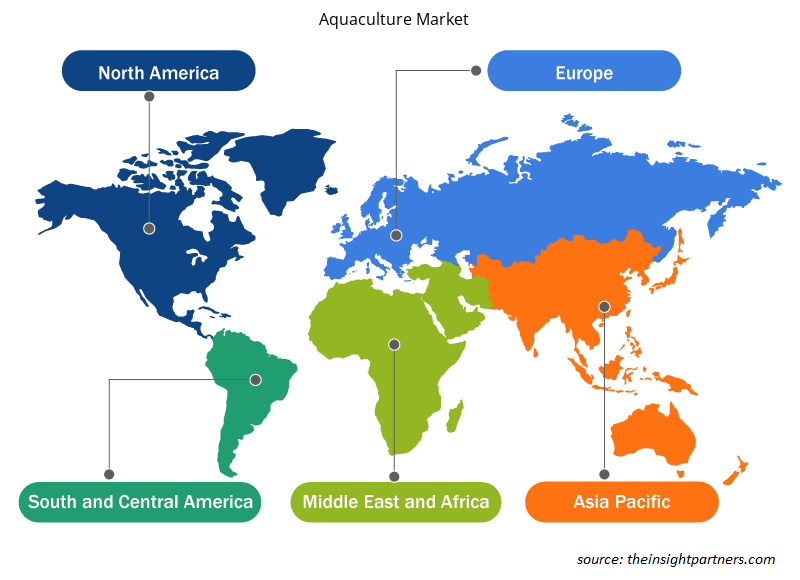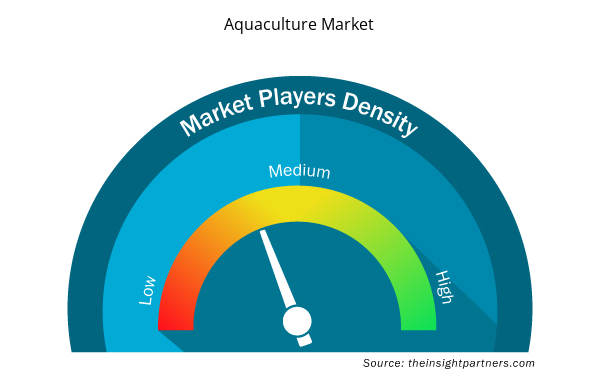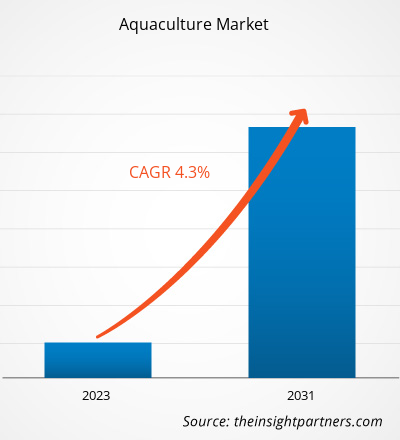Der Aquakulturmarkt soll von 406,44 Millionen US-Dollar im Jahr 2023 auf 289,66 Milliarden US-Dollar im Jahr 2031 anwachsen. Der Markt soll zwischen 2023 und 2031 eine durchschnittliche jährliche Wachstumsrate von 4,3 % verzeichnen. Die zunehmende Einführung der Technologie der Kreislaufaquakultursysteme (RAS) in der gesamten Welt, in der Fische und andere Wassertiere durch Wiederverwendung des Wassers gezüchtet werden, wird wahrscheinlich weiterhin ein wichtiger Trend im Aquakulturmarkt bleiben.
Aquakultur-Marktanalyse
Die Ernährungs- und Landwirtschaftsorganisation der Vereinten Nationen (UN FAO) hat eine Lücke zwischen Angebot und Nachfrage nach Meeresfrüchten für die Zukunft erkannt. Prognosen zufolge wird die Nachfrage nach Meeresfrüchten bis 2030 260 Millionen Tonnen übersteigen, und das geschätzte Angebot bei der aktuellen Produktionsrate wird 210 Millionen Tonnen betragen. Daher gilt die Aquakultur als eine fähige Quelle, um die erhöhte Nachfrage nach Meeresfrüchten zu decken. Außerdem gibt es nur wenige Zertifizierungen und Standards im Zusammenhang mit der Produktion von Meeresfrüchten für eine nachhaltige Umwelt. Der World Wildlife Fund for Nature (WWF) und die Dutch Sustainable Trade Initiative (IDH) haben den Aquaculture Stewardship Council (ASC) ins Leben gerufen, der im Jahr 2010 ins Leben gerufen wurde. Das Ziel dieses Rates ist es, die weltweiten Märkte für Meeresfrüchte umzugestalten, um die soziale Leistung der Aquakultur zu fördern.
Aquakulturmarktübersicht
Aquakultur umfasst die Zucht von Fischen, Wasserpflanzen , Algen, Krebstieren, Weichtieren und anderen Wasserorganismen. Kleinangelegte Aquakulturmärkte in Industrie- und Entwicklungsländern leisten einen wichtigen Beitrag zur Beschäftigung. Laut der Ernährungs- und Landwirtschaftsorganisation (FAO) bietet die Aquakultur weltweit über 41 Millionen Menschen Arbeit. Aufgrund der steigenden Nachfrage nach Meeresfrüchten macht die Fischproduktion den Großteil der Aquakulturaktivitäten in Entwicklungsländern aus. Fisch und andere Meeresfrüchte sind eine wichtige Nährstoffquelle für Menschen unterhalb der Armutsgrenze und gehören zu den billigsten Formen tierischer Proteine. Die Aquakultur gilt als wichtiger Sektor zur Deckung der steigenden Nachfrage nach Fisch, die mit Bevölkerungswachstum, steigenden Einkommen und zunehmender Urbanisierung weiter steigen wird.
Passen Sie diesen Bericht Ihren Anforderungen an
Sie erhalten kostenlos individuelle Anpassungen an jedem Bericht, einschließlich Teilen dieses Berichts oder einer Analyse auf Länderebene, eines Excel-Datenpakets sowie tolle Angebote und Rabatte für Start-ups und Universitäten.
- Holen Sie sich die wichtigsten Markttrends aus diesem Bericht.Dieses KOSTENLOSE Beispiel umfasst eine Datenanalyse von Markttrends bis hin zu Schätzungen und Prognosen.
Treiber und Chancen auf dem Aquakulturmarkt
Steigende Nachfrage und Konsum von Meeresfrüchten treiben den Markt an
Meeresfrüchte, insbesondere Fisch, sind in vielen Regionen Teil der traditionellen Nahrung. Außerdem wird Fisch aufgrund seines Nährwerts und seiner zahlreichen gesundheitlichen Vorteile häufig verzehrt. Er gilt als gute Quelle für Fettsäuren, Vitamine, Mineralien, Proteine und wichtige Mikronährstoffe . Das steigende verfügbare Einkommen und die Kaufkraft der Verbraucher lassen auch ihre Ausgaben für tierische Proteine wie Meeresfrüchte im Vergleich zu anderen Lebensmittelkategorien ansteigen. Gegenwärtig haben das starke Bevölkerungswachstum und die zunehmende Beliebtheit von Meeresfrüchten als gesunde Proteinquelle das Wachstum des Aquakulturmarktes angekurbelt.
Anwendung von Fischöl in verschiedenen Branchen – eine Chance auf dem Aquakulturmarkt
Aquakultur ist eine effiziente Methode zur Fischproduktion, die ökologisch effektiv ist und weniger Kosten verursacht, da diese Unternehmungen sowohl im großen als auch im kleinen Maßstab betrieben werden können. Die stark steigende Nachfrage nach Fischöl führt zu einem Bedarf an mehr Fischproduktion und erhöht somit die Nachfrage nach Aquakultur in naher Zukunft. Fischöl wird weitgehend als Nahrungsergänzungsmittel, in der Gesundheitspflege, in der Pharmazie und in der Lebensmittelindustrie verwendet. Es ist eine wirksame Quelle für Vitamin A und D und gilt nach Wildfisch als die wichtigste Vitaminquelle für den menschlichen Verzehr.
Segmentierungsanalyse des Aquakulturmarktberichts
Schlüsselsegmente, die zur Ableitung der Aquakulturmarktanalyse beigetragen haben, sind Typ und Anwendung.
- In Bezug auf den Produkttyp ist der Markt in Fische, Wasserpflanzen, Krebstiere, Weichtiere und andere unterteilt. Das Fischsegment dominierte den Markt im Jahr 2023.
- Basierend auf der Kulturumgebung ist der Aquakulturmarkt in Süßwasser, Meerwasser und Brackwasser unterteilt. Das Meeressegment hatte im Jahr 2023 einen größeren Marktanteil.
Aquakultur-Marktanteilsanalyse nach Geografie
Der geografische Umfang des Aquakulturmarktberichts ist hauptsächlich in fünf Regionen unterteilt: Nordamerika, Asien-Pazifik, Europa, Naher Osten und Afrika sowie Südamerika/Süd- und Mittelamerika.
Der Aquakulturmarkt im asiatisch-pazifischen Raum hat im Laufe der Jahre einen enormen Wandel erlebt. Die Produktion und der Verbrauch von Meeresfrüchten steigen rasant an, wobei China und Indien die wichtigsten Märkte für die Aquakulturindustrie sind. Der asiatisch-pazifische Raum hat sich zum größten Verbraucher und Exporteur von Aquakulturprodukten entwickelt. Fischerei und Aquakulturproduktion sind zwei der wichtigsten Sektoren, die erheblich zum Wirtschaftswachstum der asiatisch-pazifischen Länder beitragen. Der wirtschaftliche Beitrag der Aquakulturproduktion ist jedoch in den süd- und südostasiatischen Staaten geringer. Meeresfrüchte gehören zu den meistgehandelten Gütern im asiatisch-pazifischen Raum und bringen dieser Region wertvolle Deviseneinnahmen. In den letzten Jahren sind Entwicklungsländer wie Indien und Thailand zu Nettoexporteuren von Fisch geworden, und ein ähnlicher Trend wird den Aquakulturmarkt im asiatisch-pazifischen Raum in den kommenden Jahren voraussichtlich ankurbeln.
Regionale Einblicke in den Aquakulturmarkt
Die regionalen Trends und Faktoren, die den Aquakulturmarkt im Prognosezeitraum beeinflussen, wurden von den Analysten von Insight Partners ausführlich erläutert. In diesem Abschnitt werden auch die Marktsegmente und die Geografie des Aquakulturmarkts in Nordamerika, Europa, im asiatisch-pazifischen Raum, im Nahen Osten und Afrika sowie in Süd- und Mittelamerika erörtert.

- Erhalten Sie regionalspezifische Daten zum Aquakulturmarkt
Umfang des Aquakulturmarktberichts
| Berichtsattribut | Details |
|---|---|
| Marktgröße im Jahr 2023 | 406,44 Millionen US-Dollar |
| Marktgröße bis 2031 | 289,66 Milliarden US-Dollar |
| Globale CAGR (2023 - 2031) | 4,3 % |
| Historische Daten | 2021-2022 |
| Prognosezeitraum | 2023–2031 |
| Abgedeckte Segmente | Nach Produkttyp
|
| Abgedeckte Regionen und Länder | Nordamerika
|
| Marktführer und wichtige Unternehmensprofile |
|
Dichte der Akteure auf dem Aquakulturmarkt: Deren Auswirkungen auf die Geschäftsdynamik
Der Aquakulturmarkt wächst rasant, angetrieben durch die steigende Endverbrauchernachfrage aufgrund von Faktoren wie sich entwickelnden Verbraucherpräferenzen, technologischen Fortschritten und einem größeren Bewusstsein für die Vorteile des Produkts. Mit steigender Nachfrage erweitern Unternehmen ihr Angebot, entwickeln Innovationen, um die Bedürfnisse der Verbraucher zu erfüllen, und nutzen neue Trends, was das Marktwachstum weiter ankurbelt.
Die Marktteilnehmerdichte bezieht sich auf die Verteilung der Firmen oder Unternehmen, die in einem bestimmten Markt oder einer bestimmten Branche tätig sind. Sie gibt an, wie viele Wettbewerber (Marktteilnehmer) in einem bestimmten Marktraum im Verhältnis zu seiner Größe oder seinem gesamten Marktwert präsent sind.
Die wichtigsten auf dem Aquakulturmarkt tätigen Unternehmen sind:
- Bakkafrost
- Blue Ridge Aquaculture, Inc.
- Cermaq Group AS
- Cooke Aquaculture Inc
- Dänischer Lachs A/S
Haftungsausschluss : Die oben aufgeführten Unternehmen sind nicht in einer bestimmten Reihenfolge aufgeführt.

- Überblick über die wichtigsten Akteure auf dem Aquakulturmarkt
Neuigkeiten und aktuelle Entwicklungen zum Aquakulturmarkt
Der Aquakulturmarkt wird durch die Erhebung qualitativer und quantitativer Daten nach Primär- und Sekundärforschung bewertet, die wichtige Unternehmensveröffentlichungen, Verbandsdaten und Datenbanken umfasst. Im Folgenden finden Sie eine Liste der Entwicklungen auf dem Markt für Innovationen, Geschäftserweiterungen und Strategien:
- Im Juni 2021 gab JBS SA eine Vereinbarung zur 100-prozentigen Übernahme von Huon Aquaculture, Australiens zweitgrößtem Lachsproduzenten, bekannt. Dies ist eine strategische Übernahme, die den Einstieg von JBS in das Aquakulturgeschäft markiert. (Quelle: JBS SA, Pressemitteilung)
- Im Januar 2022 kann Bakkafrost mit der Übernahme von Munkebo Seafood nun eine breitere Produktpalette anbieten. Bakkafrost bietet frische, gefrorene und geräucherte Lachsprodukte an, und jetzt kommen auch Konserven hinzu. Bakkafrost verfügt über ein globales Vertriebsnetz, und die Produkte von Munkebo Seafood werden nun auf einem breiteren Markt als Ergänzung zu den anderen verpackten Verbraucherprodukten von Bakkafrost angeboten. (Quelle: Bakkafrost, Newsletter)
Aquakultur-Marktbericht – Umfang und Ergebnisse
Der Bericht „Marktgröße und Prognose für Aquakultur (2023–2031)“ bietet eine detaillierte Analyse des Marktes, die die folgenden Bereiche abdeckt:
- Marktgröße und Prognose auf globaler, regionaler und Länderebene für alle wichtigen Marktsegmente, die im Rahmen des Projekts abgedeckt sind
- Marktdynamik wie Treiber, Beschränkungen und wichtige Chancen
- Wichtige Zukunftstrends
- Detaillierte PEST/Porters Five Forces- und SWOT-Analyse
- Globale und regionale Marktanalyse mit wichtigen Markttrends, wichtigen Akteuren, Vorschriften und aktuellen Marktentwicklungen
- Branchenlandschaft und Wettbewerbsanalyse, einschließlich Marktkonzentration, Heatmap-Analyse, prominenten Akteuren und aktuellen Entwicklungen
- Detaillierte Firmenprofile
- Historische Analyse (2 Jahre), Basisjahr, Prognose (7 Jahre) mit CAGR
- PEST- und SWOT-Analyse
- Marktgröße Wert/Volumen – Global, Regional, Land
- Branche und Wettbewerbsumfeld
- Excel-Datensatz



Report Coverage
Revenue forecast, Company Analysis, Industry landscape, Growth factors, and Trends

Segment Covered
This text is related
to segments covered.

Regional Scope
North America, Europe, Asia Pacific, Middle East & Africa, South & Central America

Country Scope
This text is related
to country scope.
Trends and growth analysis reports related to Food and Beverages : READ MORE..
The Insight Partners performs research in 4 major stages: Data Collection & Secondary Research, Primary Research, Data Analysis and Data Triangulation & Final Review.
- Data Collection and Secondary Research:
As a market research and consulting firm operating from a decade, we have published and advised several client across the globe. First step for any study will start with an assessment of currently available data and insights from existing reports. Further, historical and current market information is collected from Investor Presentations, Annual Reports, SEC Filings, etc., and other information related to company’s performance and market positioning are gathered from Paid Databases (Factiva, Hoovers, and Reuters) and various other publications available in public domain.
Several associations trade associates, technical forums, institutes, societies and organization are accessed to gain technical as well as market related insights through their publications such as research papers, blogs and press releases related to the studies are referred to get cues about the market. Further, white papers, journals, magazines, and other news articles published in last 3 years are scrutinized and analyzed to understand the current market trends.
- Primary Research:
The primarily interview analysis comprise of data obtained from industry participants interview and answers to survey questions gathered by in-house primary team.
For primary research, interviews are conducted with industry experts/CEOs/Marketing Managers/VPs/Subject Matter Experts from both demand and supply side to get a 360-degree view of the market. The primary team conducts several interviews based on the complexity of the markets to understand the various market trends and dynamics which makes research more credible and precise.
A typical research interview fulfils the following functions:
- Provides first-hand information on the market size, market trends, growth trends, competitive landscape, and outlook
- Validates and strengthens in-house secondary research findings
- Develops the analysis team’s expertise and market understanding
Primary research involves email interactions and telephone interviews for each market, category, segment, and sub-segment across geographies. The participants who typically take part in such a process include, but are not limited to:
- Industry participants: VPs, business development managers, market intelligence managers and national sales managers
- Outside experts: Valuation experts, research analysts and key opinion leaders specializing in the electronics and semiconductor industry.
Below is the breakup of our primary respondents by company, designation, and region:

Once we receive the confirmation from primary research sources or primary respondents, we finalize the base year market estimation and forecast the data as per the macroeconomic and microeconomic factors assessed during data collection.
- Data Analysis:
Once data is validated through both secondary as well as primary respondents, we finalize the market estimations by hypothesis formulation and factor analysis at regional and country level.
- Macro-Economic Factor Analysis:
We analyse macroeconomic indicators such the gross domestic product (GDP), increase in the demand for goods and services across industries, technological advancement, regional economic growth, governmental policies, the influence of COVID-19, PEST analysis, and other aspects. This analysis aids in setting benchmarks for various nations/regions and approximating market splits. Additionally, the general trend of the aforementioned components aid in determining the market's development possibilities.
- Country Level Data:
Various factors that are especially aligned to the country are taken into account to determine the market size for a certain area and country, including the presence of vendors, such as headquarters and offices, the country's GDP, demand patterns, and industry growth. To comprehend the market dynamics for the nation, a number of growth variables, inhibitors, application areas, and current market trends are researched. The aforementioned elements aid in determining the country's overall market's growth potential.
- Company Profile:
The “Table of Contents” is formulated by listing and analyzing more than 25 - 30 companies operating in the market ecosystem across geographies. However, we profile only 10 companies as a standard practice in our syndicate reports. These 10 companies comprise leading, emerging, and regional players. Nonetheless, our analysis is not restricted to the 10 listed companies, we also analyze other companies present in the market to develop a holistic view and understand the prevailing trends. The “Company Profiles” section in the report covers key facts, business description, products & services, financial information, SWOT analysis, and key developments. The financial information presented is extracted from the annual reports and official documents of the publicly listed companies. Upon collecting the information for the sections of respective companies, we verify them via various primary sources and then compile the data in respective company profiles. The company level information helps us in deriving the base number as well as in forecasting the market size.
- Developing Base Number:
Aggregation of sales statistics (2020-2022) and macro-economic factor, and other secondary and primary research insights are utilized to arrive at base number and related market shares for 2022. The data gaps are identified in this step and relevant market data is analyzed, collected from paid primary interviews or databases. On finalizing the base year market size, forecasts are developed on the basis of macro-economic, industry and market growth factors and company level analysis.
- Data Triangulation and Final Review:
The market findings and base year market size calculations are validated from supply as well as demand side. Demand side validations are based on macro-economic factor analysis and benchmarks for respective regions and countries. In case of supply side validations, revenues of major companies are estimated (in case not available) based on industry benchmark, approximate number of employees, product portfolio, and primary interviews revenues are gathered. Further revenue from target product/service segment is assessed to avoid overshooting of market statistics. In case of heavy deviations between supply and demand side values, all thes steps are repeated to achieve synchronization.
We follow an iterative model, wherein we share our research findings with Subject Matter Experts (SME’s) and Key Opinion Leaders (KOLs) until consensus view of the market is not formulated – this model negates any drastic deviation in the opinions of experts. Only validated and universally acceptable research findings are quoted in our reports.
We have important check points that we use to validate our research findings – which we call – data triangulation, where we validate the information, we generate from secondary sources with primary interviews and then we re-validate with our internal data bases and Subject matter experts. This comprehensive model enables us to deliver high quality, reliable data in shortest possible time.


 Holen Sie sich ein kostenloses Muster für diesen Bericht
Holen Sie sich ein kostenloses Muster für diesen Bericht